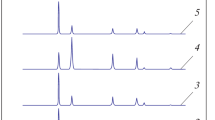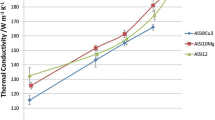Abstract
Using a low-temperature calorimeter annealing effects were investigated in high-purity aluminium of varying grades of purity (Al 99.99, Al 99.999 and Al 99.9999) which had been subjected to deformation by torsion at liquid nitrogen. For the purpose of comparison, some residual resistivity measurements were performed on deformed and quenched Al 99.999.
The calorimetric signals comprises two consecutive peaks (low-temperature peak and high-temperature peak) for each degree of deformation and purity. The low-temperature peak, with a maximum at 200 K-210 K, lies in the temperature range stage III, well-known from isochronous resistivity measurements. The effective activation energy of the annealing defects in this peak has the valueQ m=0.62 eV/atom averaged over all degrees of deformation and purity, and is thus close to the known values of the activation energy of vacancy migration. Throughout the high-temperature peak, the position of which on the temperature scale depends strongly on the degree of deformation and purity, the processes of primaty recrystallization and dislocation recovery take place in the material. The coincidence of this peak with the changes of mechanical and electrical properties are in accordance with this interpretation. Thus to the usual nomenclature for isochronous resistance measurements, one may designate this peak a “stage V” reaction peak.
In this paper the particular results of the low-temperature peak (“stage III” peak) are analysed and discussed. Then the experimental data are compared with the literature data derived from other measuring procedures.
Similar content being viewed by others
References
Sassa, K., Petry, W., Vogl, G.: Philos. Mag. A48 (No. 1), 41–61 (1982)
Ceresara, S., Elkholy, H., Federighi, T.: Philos. Mag.12, 1105 (1965)
Frois, C.: Acta Metall.14, 1325 (1966)
Ceresara, S.: Philos. Mag.19, 99 (1969)
Lugscheider, W., Breitenfellner, F., Lihl, F.: Z. Metallkd.59, 22 (1968)
Hegazi, A., Kovács, I., Nagy, E.: Phys. Status Solidi33, 131 (1969)
Kozinets, V.V.: Phys. Met. Metall.53 (No. 5), 136–138 (1982)
Vostry', P., Haslar, V., Sprusil, B.: Mater. Sci. Forum15–18, 795–800 (1987)
Wollenberger, H.J.: Point defects. In: Physical metallurgy. Cahn, R.W., Haasen, P. (eds.), p. 1139. Amsterdam: Elsevier Science Publishers 1983
Hashimoto, E., Ono, K., Kino, T.: J. Phys. Soc. Jpn.42, (No. 3), 868 (1977)
Harvyama, O.: Jpn. Appl. Phys.20 (No. 9), 1641 (1981)
Nasu, S., Preston, R.S., Gonser, U.: Mater. Sci. Forum15–18, 599–604 (1987)
Müller, H.G.: Z. Phys. B—Condensed Matter47, 119–127 (1982)
Rajainmäki, H., Linderoth, S., Nieminen, R.M., Hansen, H.E.: Mater. Sci. Forum15–18, 611–616 (1987)
Kanazawa, I., Murakami, H., Doyama, M.: Mater. Sci. Forum15–18, 919–924 (1987)
Schmidt, J.: Thermochim. Acta151, 333–344 (1989)
Bueren, H.G. van: Z. Metallkd.46, 272 (1955)
Haeßner, F., Schmidt, J.: Scr. Met.22, 1917 (1988)
Siegel, R.W.: J. Nucl. Mater.69,70, 117 (1978)
Saada, G.: Acta Metall.9, 166, 965 (1961)
Beukel, A. van den: Point defects in cold worked fcc metals. In: Vacancies and interstitials in metals. Seeger, A., Schumacher, D., Schilling, W., Diehl, J. (eds.), p. 427. Amsterdam: North-Holland 1970
Balluffi, R.W.: J. Nucl. Mater.69, 70, 240 (1978)
Haeßner, F., Schönborn, K.H.: Z. Metallkd.76, 198 (1985)
Schönborn, K.H., Haeßner, F.: Thermochim. Acta86, 305–320 (1985)
Sestak', J.: Thermophysical properties of solids. Their measurements and theoretical thermal analysis. In: Comprehensive analytical chemistry. Svehla, G. (ed.), Vol. XII, Part D, p. 212ff. Amsterdam: Elsevier 1984
Christian, J.W.: The theory of transformations in metals and alloys. Part I: Equilibrium and general kinetic theory. Raynor, G.V. (ed.), p. 542ff. New York: Pergamon Press 1975
Seeger, A.: Moderne Probleme der Metallphysik. Seeger, A. (ed.) p. 245. Berlin, Heidelberg, New York: Springer 1965
Nihoul, J., Stals, L.: Phys. Status Solidi17, 295 (1966)
Streda, P.: Crystal Latt. Def.1, 229–235 (1970)
Author information
Authors and Affiliations
Rights and permissions
About this article
Cite this article
Schmidt, J., Haeßner, F. Stage III-recovery of cold worked high-purity aluminium determined with a low-temperature calorimeter. Z. Physik B - Condensed Matter 81, 215–222 (1990). https://doi.org/10.1007/BF01309351
Received:
Revised:
Issue Date:
DOI: https://doi.org/10.1007/BF01309351




